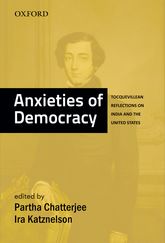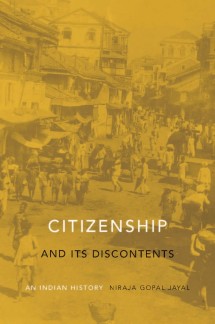Anxieties of Democracy: Tocquevillean Reflections on India and the United States by Partha Chatterjee and Ira Katznelson (eds). New Delhi: Oxford University Press, 2012; Citizenship and Its Discontents: An Indian History by . Cambridge: Harvard University Press, 2013.
What are the preconditions for the development and sustenance of democracy in a country? While modernisation theorists argue that the modernisation of agriculture and development of an urban bourgeois class are essential for democracy, Marxists argue that the bourgeoisie resists democratisation when it seems to threaten their interest – it is the working class which usually pushes for democracy. India has neither gone through a modernisation process nor had a break from the traditional past. It has neither had a vigorous dominant indigenous bourgeoisie nor a strong working class. What it has had is a strong feudal system, a large and mostly disorganised peasantry, a rigid, hierarchical social structure, widespread poverty and illiteracy, and a very small and weak middle class – not a congenial setting for democracy. Despite all this, democracy has not only survived, but has become sturdier over time. The question is: How has democracy survived in India despite inhospitable conditions and broken promises? Addressing this, Chatterjee and Katznelson’s Anxieties of Democracy and Jayal’s Citizenship and Its Discontents urge readers to understand the complex and contingent relationship between state and society and between democracy and citizenship in the modern world.
Anxieties of Democracy grew out of collaborative intellectual engagements between American and Indian political scientists. It has an introduction by Chatterjee and Katznelson and nine essays by eminent political scientists, which provide comparative theoretical analysis of the Indian and American experiences of democracy. The introduction by Chatterjee and Katznelson sets the tone of the book where they examine the relevance of Tocquevillean insights to understanding the functioning of present-day democracy. The book examines the ‘entrenched structures of inequality’ (p. 10) such as race relations in the United States and the caste system in India that have constrained democratic citizenship; and it identifies ways through which these societies have managed to include the excluded populations in the political process. The authors view democracy as a process that aims to create the ‘social condition of equality’ (p. 9) for all. However, despite all efforts, structures of inequality have continued to prevail on the basis of caste, race, ethnicity and gender. To address this, Kaviraj urges strengthening the relationship between democratic government and democratic society, which can be achieved through the institutions of civil and political society. It is, however, seen that modern capitalist states have restricted the role of civil society; instead, they have strengthened the role of market forces, which have proven unfavourable to the interests of the poor and marginalised populations.
The questions then are: How can we extend democratic citizenship to the marginalised populations and make them equal partners in the democratic process? What are the ways through which the poor can overcome structural inequalities such as caste, race and gender and live a life of dignity and mutual respect? It is in this context that Niraja Jayal’s Citizenship and Its Discontents makes a significant contribution. Her book provides a biography of the Indian idea of citizenship in the twentieth century that has tried to address caste-based discrimination, marginality and inequality. Although Jayal admits that there is ‘no easy resolution of the contention between principles of universal and group-differentiated citizenship’ (p. 3), she argues that ‘[a] recognition of [such] disadvantage requires us to provide for group-differentiated citizenship through instruments such as affirmative action policies’ (p. 3). In this regard, the Indian state and democracy have made provisions not only of affirmative action, but also of a range of welfare programmes to improve the status of people from low caste and minority groups. Indian civil society has also played a significant role in making sure that the interests and rights of the marginalised do not get trampled or ignored.
Following a historical perspective, Jayal discusses three aspects of citizenship: (1) as legal status, (2) as rights and entitlements, and (3) as a form of identity and belonging. These three aspects of citizenship are explored in great detail in three parts of the book. Part I argues that citizenship, which was based on race and class in the colonial period, has been broadly based on the principle of jus soli since independence, although recently jus sanguinis is also adopted by the state. Part II discusses the move from civil and political to social and economic rights, which is an attempt to transform procedural democracy to a substantive one. In Part III, Jayal discusses how the Indian state has implemented the group-differentiated and community-mediated citizenship as an undertaking to address ‘backwardness’ and discrimination. Jayal concludes that it is not just ‘the legal status of membership but also the principles of social citizenship and group-differentiated citizenship that facilitate the fullest realisation of a unique civic community in a diverse society [like India] marked by multiple and deep inequalities’ (p. 24).
Although Chatterjee and Katznelson’s book provides a strong comparative perspective, some chapters have imposed Tocqueville into the analysis, which does not fit very well. In contrast, Jayal’s book provides a strong historical-sociological perspective, which I enjoyed the most; it is empirically sound and theoretically sophisticated. Both the books are lucid and well-argued and should be recommended to students of sociology, comparative politics and India Studies.
________________
Sarbeswar SAHOO (2014) Political Studies Review, Vol.12, Issue.2, May, pp.330-331


Leave a comment